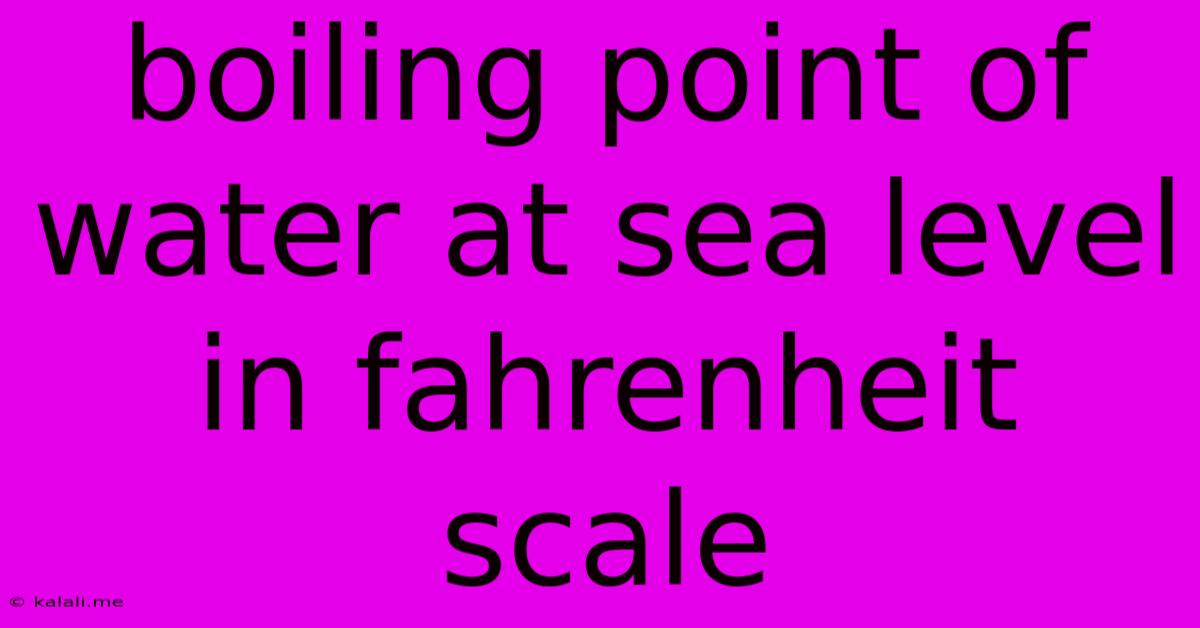Boiling Point Of Water At Sea Level In Fahrenheit Scale
Kalali
Jun 13, 2025 · 3 min read

Table of Contents
Boiling Point of Water at Sea Level: A Fahrenheit Perspective
The boiling point of water is a fundamental concept in science and everyday life. While many are familiar with the Celsius equivalent (100°C), understanding the Fahrenheit equivalent is equally important, especially for those in regions that primarily use the Fahrenheit scale. This article will delve into the boiling point of water at sea level specifically in Fahrenheit, exploring the factors that influence this temperature and its significance in various applications.
What is the Boiling Point of Water at Sea Level in Fahrenheit?
The boiling point of water at sea level is 212° Fahrenheit (212°F). This seemingly simple number represents the temperature at which liquid water transitions into its gaseous state, steam, under standard atmospheric pressure. Understanding this precise temperature is crucial in numerous scientific experiments, cooking processes, and industrial applications.
Factors Affecting the Boiling Point
While 212°F is the standard at sea level, several factors can influence the boiling point of water:
-
Altitude: As altitude increases, atmospheric pressure decreases. This lower pressure means water boils at a lower temperature. For example, at high altitudes like those found in mountainous regions, water will boil at a temperature significantly below 212°F. This is why cooking times often need to be adjusted at higher elevations.
-
Pressure: Similar to altitude, increased pressure increases the boiling point. Pressure cookers utilize this principle to cook food faster by raising the pressure and thus the boiling point of water within the sealed container.
-
Impurities: The presence of dissolved substances in water, such as salts or minerals, can slightly elevate its boiling point. This effect, however, is generally negligible in most everyday scenarios.
Significance of the Boiling Point
The boiling point of water holds significant importance in various fields:
-
Cooking: Understanding the boiling point is crucial for cooking, particularly when adjusting recipes for different altitudes or using pressure cookers. Accurate temperature control ensures food is cooked properly and safely.
-
Chemistry and Physics: The boiling point is a fundamental physical property used in various scientific experiments and calculations. It's a key parameter in determining the purity of substances and understanding phase transitions.
-
Engineering: Engineers utilize boiling point data in the design of various systems, including steam engines, power plants, and chemical processes, ensuring efficient and safe operation.
Misconceptions about Boiling Point
It's important to address some common misconceptions regarding the boiling point of water:
-
Boiling faster doesn't mean higher temperature: Adding more heat to boiling water will not increase its temperature beyond the boiling point; it simply increases the rate of vaporization.
-
Boiling point is not a fixed point: While 212°F at sea level is a standard, remember that the boiling point is dependent on external factors like pressure and altitude.
In conclusion, the boiling point of water at sea level, 212°F, is a critical value in numerous contexts. Understanding this temperature and the factors that affect it is essential for anyone working in scientific, culinary, or engineering fields, and it provides a foundational understanding of the properties of water itself. By grasping this fundamental concept, we gain a deeper appreciation for the intricate science behind everyday occurrences.
Latest Posts
Latest Posts
-
The Maximum Bcd Value Of A Single Decimal Is
Jun 14, 2025
-
All Of The Following Nucleotide Bases Are Pyrimidines Except
Jun 14, 2025
-
Which Of The Following Is Not A Measure Of Retention
Jun 14, 2025
-
First British Governor General Of India
Jun 14, 2025
-
What Are Blocks In The Periodic Table
Jun 14, 2025
Related Post
Thank you for visiting our website which covers about Boiling Point Of Water At Sea Level In Fahrenheit Scale . We hope the information provided has been useful to you. Feel free to contact us if you have any questions or need further assistance. See you next time and don't miss to bookmark.